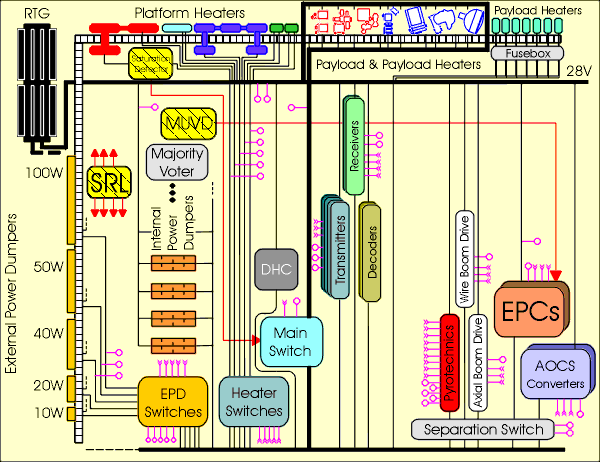Power - Ulysses
Power & Thermal Subsystem
During the mission, the solar flux on the spacecraft varies from about 45W to 1500W per square metre. Such a large variation in the environment makes thermal control difficult. The effect of changing solar intensity on the spacecraft is controlled by the use of low absorbance thermal blankets, and by the capability to dump power outside the spacecraft to reduce heating by internal dissipation.
All power is provided by a Radioisotope Thermoelectric Generator (RTG) supplied by NASA, which had a beginning of mission power of about 283W and was predicted to have an end-of-mission (originally planned to be in 1995) power of about 255W. The spacecraft is currently operating with an RTG power of 202W.
Regulated 28V power is provided to all users, incorporating overload protection and automatic reconfiguration after failure. Dedicated converters provide other necessary voltages to the subsystems and experiments.
Power not consumed by operational units is dissipated to resistors termed Internal Power Dumpers (IPDs) inside the spacecraft to contribute to general heating. This power can be diverted to resistors outside the spacecraft - External Power Dumpers, (EPDs) - when the spacecraft interior becomes too warm. EPDs are selectable in steps of 10W.
In addition to the general heating provided by the IPDs, specific areas of the spacecraft have dedicated heaters. The tank and fuel lines are served by the appropriately named Hot Case and Cold Case heaters, used when the spacecraft is close to and far from the Sun. The +X and -X wing heaters are used to control the temperatures of the thruster blocks, and there is also a heater on the longeron near the Reaction Control subsystem (RCS) fill and vent valve.
Click on an area of the diagram for more on specific units.
Click on the next link to see the rated power consumption of all spacecraft electrical units.








































 Sign in
Sign in
 Science & Technology
Science & Technology
